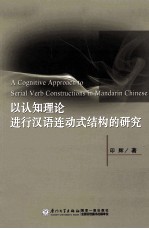图书介绍
以认知理论进行汉语连动式结构的研究 英文版PDF|Epub|txt|kindle电子书版本网盘下载

- 印辉著 著
- 出版社: 厦门:厦门大学出版社
- ISBN:9787561545270
- 出版时间:2012
- 标注页数:179页
- 文件大小:7MB
- 文件页数:191页
- 主题词:汉语-复杂谓语-语法结构-研究
PDF下载
下载说明
以认知理论进行汉语连动式结构的研究 英文版PDF格式电子书版下载
下载的文件为RAR压缩包。需要使用解压软件进行解压得到PDF格式图书。建议使用BT下载工具Free Download Manager进行下载,简称FDM(免费,没有广告,支持多平台)。本站资源全部打包为BT种子。所以需要使用专业的BT下载软件进行下载。如BitComet qBittorrent uTorrent等BT下载工具。迅雷目前由于本站不是热门资源。不推荐使用!后期资源热门了。安装了迅雷也可以迅雷进行下载!
(文件页数 要大于 标注页数,上中下等多册电子书除外)
注意:本站所有压缩包均有解压码: 点击下载压缩包解压工具
图书目录
Chapter 1 Introduction1
Chapter 2 Past Treatments of Serial Verb Constructions4
2.1 Past Approaches to SVCs4
2.1.1 Christaller(1875)4
2.1.2 Westermann(1930)6
2.1.3 Stewart(1963)7
2.1.4 Bamgbose(1974)9
2.1.5 Baker(1989)11
2.1.6 Agbedor(1994)13
2.1.7 Aikhenvald(2006)17
2.2 Past Approaches to Chinese SVCs21
2.2.1 Chao(1968)21
2.2.2 Li and Thompson(1981)23
2.2.3 Dai(1990)24
2.2.4 Paul(2004)27
2.3 Discussion31
Chapter 3 Basic Tenets of Cognitive Grammar32
3.1 Assumptions of Cognitive Grammar32
3.2 Symbolization34
3.3 Construction and Composition36
3.4 Base vs.Profile38
3.5 Construal39
3.6 Perspective40
3 7 Action Chain42
3.8 Lexicon and Syntax42
3.9 Schematic Representation of a Transitive Event44
Chapter 4 The Present Analysis45
4.1 Three Iconically Based Semantic Principles45
4.1.1 Principle of Temporal Sequence and Scope46
4.1.2 Principle of Shared Participants48
4.1.3 Principle of Situational Dependence48
4.2 Conceptual Event49
4.3 Laying Out the Event Conflation Continuum53
4.4 Event Structure of Coordination,Subordination,and SVCs54
4.5 Morphosyntactic and Prosodic Tests of Event Conflation57
Chapter 5 The Five Constructions and the Seven Tests62
5.1 Coordinate Constructions62
5.1.1 Schematic Representation62
5.1.2 Application of Tests63
5.1.3 Discussion64
5.2 Complement Constructions65
5.2.1 Schematic Representation65
5.2.2 Application of Tests68
5.2.3 Discussion70
5.3 Purposive Constructions70
5.3.1 Purposive Complements or Separate Clauses70
5.3.2 The Three Principles Reflected in Purposive SVCs72
5.3.3 Schematic Representation75
5.3.4 Application of the Tests75
5.3.5 Discussion77
5.4 Double-headed or Shared Object Constructions78
5.4.1 The Three Principles Reflected in Double-headed Constructions79
5.4.2 Schematic Representation80
5.4.3 Application of Tests82
5.4.4 Discussion83
5.5 The So-called VV Compounds—A Continuum Between Lexicon and syntax84
5.5.1 Parallel VV Compounds84
5.5.2 Phase VV Compounds85
5.5.3 Resultative VV Compounds87
5.5.4 Directional VV Compounds89
5.6 VV Compounds as SVCs93
5.6.1 SVCs with Complements of Result94
5.6.2 SVCs with Complements of Direction99
5.6.3 Schematic Representation104
5.6.4 Application of Tests104
5.7 Discussion106
Chapter 6 Coverb Constructions111
6.1 Traditional Criteria112
6.2 Problematic Criteria112
6.3 Verbhood Tests115
6 4 Present Analysis116
6.4.1 Coverbs—A Continuum116
6.4.2 Entities Undergoing Process118
6.5 Metaphorical and Functional Extensions118
6.5.1 Na'take'—Instrumental and Topic Marker119
6.5.2 Ba—Object Marker120
6.5.3 Gei(give)—Recipient Marker and Benefactive Use120
6.6 Differences between SVCs and CoVCs121
Chapter 7 Psycholinguistic Experiments124
7.1 Experiment One124
7.2 Experiment Two126
Chapter 8 The Association of Multi-Verb Constructions with Verbs128
8.1 Coordinate Construction129
8.2 Complement Construction132
8.3 Purposive Construction139
8.4 Shared Object Construction145
8.5 Compound Construction147
8.5.1 Contiguous Compounds Containing Lai'Come'and Qu'Go'150
8.5.2 Contiguous Compounds Containing Motion Verbs other than Lai and Qu157
Chapter 9 Conclusions161
Bibliography164